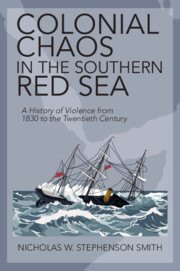71 results
3 - Warriors Who Don’t Fight
-
- Book:
- Uncertain Warriors
- Published online:
- 19 October 2023
- Print publication:
- 09 November 2023, pp 101-138
-
- Chapter
- Export citation
Somalia's evolving political market place: from famine and humanitarian crisis to permanent precarity
-
- Journal:
- The Journal of Modern African Studies / Volume 61 / Issue 3 / September 2023
- Published online by Cambridge University Press:
- 20 October 2023, pp. 343-366
- Print publication:
- September 2023
-
- Article
-
- You have access
- Open access
- HTML
- Export citation
7 - Aiding Political Violence
- from Part III - The Impact of Contemporary Rents on Dictatorship and Violence
-
- Book:
- Conquests and Rents
- Published online:
- 01 June 2023
- Print publication:
- 15 June 2023, pp 206-235
-
- Chapter
- Export citation
14 - Emigration, Displacement, and Forced Migration in Indian Ocean Africa
- from Part V - Migration by Sea
-
-
- Book:
- The Cambridge History of Global Migrations
- Published online:
- 12 May 2023
- Print publication:
- 01 June 2023, pp 277-296
-
- Chapter
- Export citation
Tensions of Modernity: Privilege, Precarity, and Colonial Nostalgia among European Security Contractors in East Africa
-
- Journal:
- Comparative Studies in Society and History / Volume 65 / Issue 3 / July 2023
- Published online by Cambridge University Press:
- 20 April 2023, pp. 702-722
-
- Article
-
- You have access
- Open access
- HTML
- Export citation
6 - Cases of Non-industrialization in Africa
-
- Book:
- Industrialization and Assimilation
- Published online:
- 18 November 2022
- Print publication:
- 22 December 2022, pp 108-135
-
- Chapter
- Export citation
Exclusive humanitarianism: Policy recommendations for genuine inclusion of persons with disabilities in humanitarian action
-
- Journal:
- International Review of the Red Cross / Volume 105 / Issue 922 / April 2023
- Published online by Cambridge University Press:
- 12 August 2022, pp. 396-415
-
- Article
- Export citation
3 - Spatial Drought Patterns in East Africa
- from Part I - Water-Related Risks under Climate Change
-
-
- Book:
- Climate Risk and Sustainable Water Management
- Published online:
- 17 March 2022
- Print publication:
- 07 April 2022, pp 47-64
-
- Chapter
- Export citation
4 - Droughts and Famine in Somalia and Ethiopia
-
- Book:
- States and Nature
- Published online:
- 03 March 2022
- Print publication:
- 24 March 2022, pp 71-119
-
- Chapter
- Export citation
Investing in mental health in Somalia: harnessing community mental health services through task shifting
-
- Journal:
- Global Mental Health / Volume 9 / 2022
- Published online by Cambridge University Press:
- 22 February 2022, pp. 94-98
-
- Article
-
- You have access
- Open access
- HTML
- Export citation
3 - Wars Other Than War
-
- Book:
- America's Wars
- Published online:
- 16 December 2021
- Print publication:
- 20 January 2022, pp 56-103
-
- Chapter
- Export citation
6 - African Intervention into Failed States
-
- Book:
- African Interventions
- Published online:
- 29 October 2021
- Print publication:
- 11 November 2021, pp 228-257
-
- Chapter
- Export citation
2 - The Beginning of the End of Diplomacy
-
- Book:
- Colonial Chaos in the Southern Red Sea
- Published online:
- 13 August 2021
- Print publication:
- 29 July 2021, pp 71-97
-
- Chapter
- Export citation
1 - Sultan Uthman’s Salvage Agreements
-
- Book:
- Colonial Chaos in the Southern Red Sea
- Published online:
- 13 August 2021
- Print publication:
- 29 July 2021, pp 30-70
-
- Chapter
- Export citation
Introduction
-
- Book:
- Colonial Chaos in the Southern Red Sea
- Published online:
- 13 August 2021
- Print publication:
- 29 July 2021, pp 1-29
-
- Chapter
- Export citation

Colonial Chaos in the Southern Red Sea
- A History of Violence from 1830 to the Twentieth Century
-
- Published online:
- 13 August 2021
- Print publication:
- 29 July 2021
3 - Pirate Hostage-Taking and Counter-Piracy Measures
-
- Book:
- Hostages and Human Rights
- Published online:
- 14 October 2021
- Print publication:
- 08 July 2021, pp 50-77
-
- Chapter
- Export citation
Chapter Four - Restoring Shari‘a: Islamic Courts in a Shattered Somalia
- from Part II - Struggles of a Broken Nation, 1991–2021
-
- Book:
- Shari‘a, Inshallah
- Published online:
- 13 May 2021
- Print publication:
- 27 May 2021, pp 159-207
-
- Chapter
- Export citation
Chapter one - Embracing Shari‘a and the Rule of Law
-
- Book:
- Shari‘a, Inshallah
- Published online:
- 13 May 2021
- Print publication:
- 27 May 2021, pp 31-62
-
- Chapter
- Export citation
Introduction
-
- Book:
- Shari‘a, Inshallah
- Published online:
- 13 May 2021
- Print publication:
- 27 May 2021, pp 1-30
-
- Chapter
- Export citation



